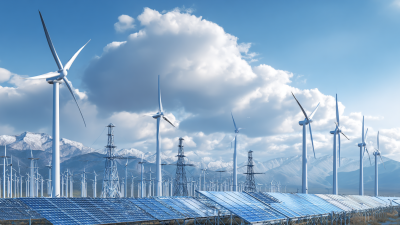Wind Farm Energy Innovations at 2025 China Import and Export Fair: Harnessing a $1 Trillion Industry
As the global energy landscape undergoes a transformative shift, the significance of wind farm energy innovations emerges prominently, particularly highlighted at the 2025 China Import and Export Fair. This event reflects the surging momentum within the wind energy sector, which is projected to reach a staggering $1 trillion by 2030, according to a recent report from the Global Wind Energy Council. Countries are increasingly recognizing the role of wind farms as a key component in achieving carbon neutrality, with forecasted growth rates of 8.4% in installed capacity over the next decade.

China, as a major player in the wind energy market, is showing remarkable advancements in technologies that enhance efficiency and output, making it a focal point for international collaboration and investment. The fair presents a unique platform to showcase these innovations and solidify partnerships that drive the future of sustainable energy.
Innovative Wind Energy Technologies Showcased at the 2025 China Import and Export Fair
The 2025 China Import and Export Fair is set to be a pivotal platform for showcasing groundbreaking innovations in wind energy technologies. As the world rapidly shifts toward sustainable energy solutions, this fair will highlight the advancements that are positioning wind power at the forefront of the renewable energy sector. Companies from around the globe will present their latest innovations, including more efficient turbine designs, integrated energy storage systems, and cutting-edge software for optimizing energy output.
Among the innovations, we can expect to see improvements in turbine materials that enhance durability and efficiency, as well as advancements in offshore wind energy deployment. These technologies not only promise to reduce costs but also aim to increase energy harnessing capabilities in diverse environments.
The fair will serve as a crucial meeting point for industry leaders, researchers, and policymakers, fostering collaboration that can drive the wind energy sector's rapid growth towards the ambitious target of harnessing a $1 trillion industry. As nations prioritize green energy, the developments showcased at this event will play a significant role in shaping the future landscape of energy production worldwide.
Global Collaboration Opportunities in the Wind Energy Sector
At the 2025 China Import and Export Fair, the spotlight will be on global collaboration opportunities in the wind energy sector, a rapidly expanding industry expected to reach a staggering $1 trillion in value. With China leading the charge in wind energy technologies, international partnerships are more crucial than ever. Countries around the world can benefit from sharing research, innovations, and best practices to tackle common challenges such as energy storage and offshore wind deployment.
Tips for engaging in global collaboration include identifying key players within the industry, such as technology suppliers and renewable energy policymakers. Establishing clear communication channels and developing joint ventures can also enhance project outcomes and foster innovation. Attendees at the fair should consider participating in workshops and networking sessions to connect with potential partners across various markets.
In addition, exploring funding opportunities for collaborative projects is essential. Governments and international organizations are increasingly focused on sustainable energy solutions, often providing grants or incentives for innovative wind energy initiatives. By leveraging these financial resources, stakeholders can pave the way for successful collaborations that not only advance technology but also contribute to global sustainability goals.

Sustainable Practices in Wind Farm Development and Operations
The wind energy sector is experiencing rapid growth, with investments in sustainable practices becoming crucial for long-term success. According to the Global Wind Energy Council (GWEC) report, the global wind energy market is projected to reach $1 trillion by 2025, highlighting the immense potential for innovations in wind farm development and operations. Emphasizing sustainability, many companies are now adopting eco-friendly technologies and practices that not only reduce carbon footprints but also enhance efficiency. For instance, the integration of advanced turbine design and predictive maintenance tools can increase energy output by 10-15%, according to the IEEE.
Moreover, sustainable practices in wind farm operations are pivotal in addressing environmental concerns. A study by the International Renewable Energy Agency (IRENA) indicated that transitioning to renewable energy could reduce global greenhouse gas emissions by up to 70% by 2050. Wind farms that utilize innovative energy storage solutions, such as battery systems and pumped hydro storage, are capable of providing consistent energy supply while optimizing resource usage. This not only benefits the environment but also ensures the economic viability of wind projects, making them attractive to investors attending events like the 2025 China Import and Export Fair.
Market Trends Driving the Growth of the Wind Energy Industry by 2025
The wind energy industry is poised for significant growth by 2025, driven by several key market trends. As the geopolitical landscape evolves and policies shift, renewables are becoming a reliable alternative to conventional energy sources. According to recent reports, the global onshore wind energy market is predicted to expand from USD 139.37 billion in 2025 to approximately USD 237.06 billion by 2034, indicating a robust compound annual growth rate (CAGR). This growth is bolstered by an increasing demand for clean energy as nations strive to meet their renewable energy targets.

Moreover, the offshore wind energy sector is also experiencing rapid advancements, particularly in floating technologies that enable energy generation in deeper waters. Research indicates that the global offshore wind energy market size is expected to reach USD 110.62 billion by 2032, with a strong growth trajectory driven by investments in renewable power. The rising popularity of floating offshore wind systems is a testament to the industry's innovation, allowing for more installations and improved efficiency. These trends underscore the wind energy sector's potential to harness a $1 trillion industry and play a pivotal role in the global energy transition by 2025.
Future Prospects: The Role of Wind Energy in China's Economic Landscape
China's economic landscape is rapidly evolving, and wind energy is playing a crucial role in this transformation. According to the Global Wind Energy Council (GWEC), China accounted for nearly 50% of the global wind energy capacity expansion in 2022, with installed capacity reaching over 300 GW. This significant investment not only contributes to reducing carbon emissions but also propels economic growth by creating jobs and fostering technological innovation. As the world shifts towards cleaner energy sources, China is poised to leverage its vast resources, positioning wind energy as a cornerstone of its sustainable development strategy.
By 2025, analysts predict that the Chinese wind energy market will be worth upwards of $1 trillion, driven by both domestic consumption and export opportunities. The Ministry of Ecology and Environment reports that the country aims to have 1,200 GW of installed wind capacity by 2030, highlighting the government's commitment to pursuing renewable energy. Innovations in turbine technology and energy storage solutions are expected to enhance efficiency and further reduce costs, making wind energy an increasingly viable option in China's energy mix. As these advancements unfold, wind energy not only stands to strengthen China's economic landscape but also serves as a model for other nations striving for a sustainable future.
Wind Farm Energy Innovations at 2025 China Import and Export Fair
| Innovation | Description | Estimated Investment (Billion USD) | Projected Energy Output (TWh/year) | Long-term Impact |
|---|---|---|---|---|
| Floating Wind Turbines | Innovative turbines that can be deployed in deep water. | 15 | 25 | Enhances energy accessibility in offshore regions. |
| Vertical Axis Wind Turbines | More efficient and suitable for urban environments. | 10 | 15 | Reduces reliance on fossil fuels and pollution. |
| Smart Wind Energy Management | AI-powered systems to optimize energy production. | 8 | 20 | Increases efficiency and contributes to grid stability. |
| Hybrid Renewable Systems | Integration of solar and wind energy solutions. | 20 | 35 | Provides reliable energy supply throughout the year. |




